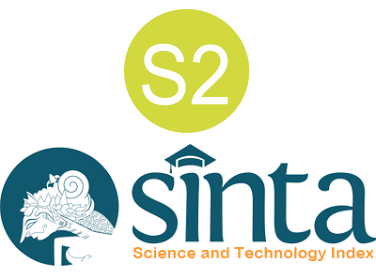Konstruksi Teologis dalam Sistem Pemujaan Śiwa-Buddha di Pura Dasar Buana Amerta Jati Śiwa Buda Desa Tajun
DOI:
https://doi.org/10.37329/jpah.v9i4.4521Keywords:
Construction, Theology, Shiva-BuddhismAbstract
Pura Dasar Buana Amerta Jati Śiwa Buda is a temple built upon the theological values of Śiva and Buddha. The effort to actualize these Śiva-Buddha theological values serves as a concrete manifestation of mahayu-hayuning bhuana (preserving the harmony of nature). The existence of the Śiva-Buddha concept in Tajun Village has raised questions from various parties regarding the theological construction present in the Bali Aga region. This study uses observation, interviews, and documentation studies as data collection methods. A qualitative descriptive method is employed to present the research findings. Based on the results, it was found that Sang Hyang Śiva and Sang Hyang Buddha are regarded as a single entity (ya Buddha ya Śiva) by the people of Tajun Village. Sang Hyang Śiva is worshipped through a pelinggih prasada, while Sang Hyang Buddha is venerated through a pelinggih stupa. The Śiva-Buddha syncretism in Pura Dasar Buana Amerta Jati Śiwa Buda has shaped the religious patterns and theological understanding of the Tajun community. A society that once viewed rwa-bhineda (duality) as something dichotomous now perceives it as paradoxical. Regardless of the chosen path whether through Śiva or Buddha, it ultimately leads to the same goal. This understanding is essentially aligned with the concept of Saguna Brahman found in Smriti texts. Engaging actively in worship of the Divine does not imply neglecting the social dimension of life, as life must remain balanced between the profane and the sacred. Furthermore, social solidarity must be built upon the principle of tatwamasi in order to be free from personal interest and to offer solutions to human problems. The theological values of Śiva-Buddha that have thus far succeeded in maintaining harmony among religious communities should continue to be preserved at all times.
References
Adnyana, I. B. G. B., & Dwipayana, I. K. A. (2019). Nilai Sosio-religius Ajaran Siwa-Buddha dalam Kakawin Sutasoma Karya Mpu Tantular. Guna Widya: Jurnal Pendidikan Hindu, 6(2), 26–37.
Ardika, I. W., Parimartha, I. G., & Wirawan, A. A. B. (2018). Sejarah Bali dari Prasejarah Hingga Modern. Denpasar: Udayana Press.
Arjawa, G. P. B. S. (2014). Pluralitas dan heterogenitas dalam konteks pembinaan kesatuan bangsa. Jurnal Kajian Budaya, 10(20), 1–20.
Dewi, N. M. E. K., Kariarta, I. W., & Heriyanti, N. (2023). Kontribusi Pura Dasar Buana Amerta Jati Śiwa Buda dalam pengembangan bahan ajar Prodi Teologi Hindu STAHN Mpu Kuturan Singaraja. Sphatika: Jurnal Teologi Hindu, 14(2), 142–150.
Gunawan, I. K. P., & Tresnayasa, M. (2025). Keberadaan Pura Sabang Daat di Desa Adat Puakan Desa Taro Kecamatan Tegallalang. Jurnal Inovasi Global, 3(1), 254–264.
Kiriana, I. N. (2021). Harmonisasi Paksa Śiwa dan Paksa Buddha di Bali (Perspektif Teologi Kontekstual). Jurnal Penelitian Agama Hindu, 5(3), 115–129.
Pemayun, C. A. S. D. (2019). Akulturasi ajaran Siwa-Buddha di Pura Pagulingan Desa Manukaya Gianyar. Kamaya: Jurnal Ilmu Agama, 2(2), 114–122.
Saitya, I. B. S., Arimbawa, I. K. S., & Jagadhita, P. P. P. (2023). Pelinggih Pajenengan as a Manifestation of Śiwa-Buddha Syncretism in the Pegulingan Temple Gianyar Bali. Jurnal Penelitian Agama Hindu, 7(4), 427–438.
Sariani, A. A. M. (2024). Konsep ketuhanan dalam Bhagavata Purana dan relevansinya terhadap teologi Hindu di Bali. Śruti: Jurnal Agama Hindu, 5(1), 1–9.
Soedijati, E. K. (1995). Solidaritas dan Masalah Sosial Kelompok Waria. Bandung: STIE Bandung.
Somawati, A. V. (2020). Filsafat ketuhanan menurut Plato dalam Perspektif Hindu. Genta Hredaya: Media Informasi Ilmiah Jurusan Brahma Widya STAHN Mpu Kuturan Singaraja, 4(1), 31–40.
Subawa, I. B. G. (2024). Agama Hindu dan Budaya Bali: Warisan Luhur dalam Kehidupan Modern. Kamaya: Jurnal Ilmu Agama, 7(4), 104–113.
Sugriwa, I.G.B. (1961). Sutasoma. Denpasar: Pustakamas
Suharyanto, A., Sihite, O., Wiflihani, Girsang, C., Ramadhan, F., Arwansyah, O. D., Siahaan, S. T., Eunike, R. B., & Wibowo, T. T. (2020). Fungsi dan Makna Bhajan pada Upacara Agama Hindu di Kuil Shri Mariamman Kota Medan. Jurnal Sitakara, 5(2), 1-15.
Sumertha, I. W., & Busro, M. Y. W. (2025). Sacred Spaces, Shared Souls: Interfaith Harmony at Taman Kemaliq Lingsar, Lombok, Indonesia. Jurnal Ilmiah Peuradeun, 13(1), 127–146.
Suwantana, I. G. (2018). Konsep Ketuhanan Dwi Tunggal Śiwa-Buddha Bahung Tringan. Sphatika: Jurnal Teologi Hindu, 9(1), 102–109.
Titib, I. M. (2003). Teologi & Simbol-Simbol dalam Agama Hindu. Surabaya: Paramita.
Wastawa, I. W. (2021). Bali: Nasionalisme dalam Religi. The Journal Publishing, 2(9), 1–243.
Widnya, I. K. (2008). Pemujaan Śiwa-Buddha dalam Masyarakat Hindu di Bali. Jurnal Mudra, 22(1), 39–54.
Wirta, I. W., & Gayatri, S. (2022). Efek Tryadic Communication Pura Samuantiga dalam pemujaan Tri Murti di Bali. Jurnal Penelitian Agama Hindu, 199–219.
Yanti, K. A. D. (2022). Sinkretisasi Śiwa-Buddha di Pura Yeh Gangga Desa Perean Tengah Kecamatan Baturiti Kabupaten Tabanan. Kamaya: Jurnal Ilmu Agama, 5(3), 141–154.
Downloads
Published
How to Cite
Issue
Section
License
Copyright (c) 2025 I Wayan Kariarta

This work is licensed under a Creative Commons Attribution-ShareAlike 4.0 International License.
An author who publishes in the Jurnal Penelitian Agama Hindu agrees to the following terms:
- Author retains the copyright and grants the journal the right of first publication of the work simultaneously licensed under the Creative Commons Attribution-ShareAlike 4.0 License that allows others to share the work with an acknowledgement of the work's authorship and initial publication in this journal
- Author is able to enter into separate, additional contractual arrangements for the non-exclusive distribution of the journal's published version of the work (e.g., post it to an institutional repository or publish it in a book) with the acknowledgement of its initial publication in this journal.
- Author is permitted and encouraged to post his/her work online (e.g., in institutional repositories or on their website) prior to and during the submission process, as it can lead to productive exchanges, as well as earlier and greater citation of the published work (See The Effect of Open Access).
Read more about the Creative Commons Attribution-ShareAlike 4.0 Licence here: https://creativecommons.org/licenses/by-sa/4.0/.








